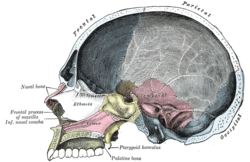- Ossification of ethmoid
-
Bone: Ossification of ethmoid Sagittal section of skull. (Ethmoid bone visible as white structure to left.) Gray's subject #36 153 The ethmoid is ossified in the cartilage of the nasal capsule by three centers: one for the perpendicular plate, and one for each labyrinth.
The labyrinths are first developed, ossific granules making their appearance in the region of the lamina papyracea between the fourth and fifth months of fetal life, and extending into the conchæ.
At birth, the bone consists of the two labyrinths, which are small and ill-developed. During the first year after birth, the perpendicular plate and crista galli begin to ossify from a single center, and are joined to the labyrinths about the beginning of the second year.
The cribriform plate is ossified partly from the perpendicular plate and partly from the labyrinths.
The development of the ethmoidal cells begins during fetal life.
This article was originally based on an entry from a public domain edition of Gray's Anatomy. As such, some of the information contained within it may be outdated.
Embryology of bones, joints, and muscles (GA 2.80, TE E5.0-2) Ossification Lower limbHeadcranium: Ossification of occipital bone · Ossification of frontal bone · Ossification of temporal bone · Ossification of sphenoid · Ossification of ethmoid
facial bones: Ossification of vomer (Sutura vomerina · Foramen vomerinum · Meatus vomerinus · Fissura vomerina) · Ossification of maxilla · Ossification of mandibleOtherOther M: JNT
anat(h/c, u, t, l)/phys
noco(arth/defr/back/soft)/cong, sysi/epon, injr
proc, drug(M01C, M4)
Categories:- Skull
- Musculoskeletal system stubs
- Developmental biology stubs
Wikimedia Foundation. 2010.

